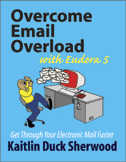The only error that I think is important is that Light Mode won't let you
change a message's label with a filter. That's pretty key to the
prioritization strategy in Chapter 2.
- One of my most respected reviewers suggests that Light users can use priority
levels in much the same way that the book discusses categories. "In my world,
priorities are (1) rarely used and (2) even more rarely helpful. Thus,
hijacking them has few downsides."
- The same reviewer also strongly encouraged me to mention a filter
that he uses for
finding spam: if his address is not in either the To or Cc line, consider it
junk mail.
I didn't put that in the book because it is somewhat dangerous, and you
shouldn't use it unless you have enough filters earlier that stop processing
on messages from people you care about. There are legitimate uses
of Bcc, as I talk about in
the book (see p.123).
If you treat all Bcc messages as junk, you might miss some important mail.
- You can type any header into the Header: box (shown by the arrow
in Figure 9, p. 45). You are not limited to using what is in the drop-down menu.
For example, a reader reports that a lot of his spam now has the date of 2016.
You can find messages that are dated far in the future by typing
Date: into the Header: box, selecting does not contain,
and typing in 2001. If you don't want to change this filter
every year, you could look for 200 instead of 2001.
- With Eudora for Mac OS, you can easily change the label of a message that
is open in its own window. Click and hold on the thin colored line at the top
of the message (shown by the arrow marked "Red" in Figure 43, p. 253).
You'll get a drop-down menu, from which you can choose a new label.
(If the message has no label, there won't be a thin colored line, but you
can still change the label by clicking where the line would be.)
- Control-d will delete all the selected messages.
- Eudora keeps the In, Out, and Trash mailboxes
in memory (RAM). If
Eudora is acting slower than you think it should, try moving messages out of
In, Out, and Trash. You might want to call the
new mailboxes something like In-old, Out-old.
- When you delete messages, even if you transfer them to Trash
and empty the trash, the messages are not truly deleted from the mailbox
file. They are only deleted from the list of messages, or Table Of Contents
(.toc) file.
Thus, if you really need to get a message back:
- Quit from Eudora.
- Find that mailbox' file.
It will be in your Eudora folder and have the same name as the mailbox.
- Copy the file. Give it a slightly different name.
- Restart Eudora.
- Eudora will rebuild the table of contents for the new mailbox, and your old
message should be in there.
Note that you should not rebuild the original mailbox' table of contents, only
a copy's. The rebuilding process will mess up some of the message status
information.
Another implication of messages not really being gone is that the still-present
messages take up still-present space. If you look at the bottom of a list of
messages (above the preview pane, if present), you'll see three numbers, such
as:
253/1047K/19K
The first number is the number of messages. The second number is the amount
of space those messages take. The third number is the amount of space that
messages marked for deletion still take up.
If you click on the third number, Eudora will compact the messages in
that mailbox. It should then become zero, such as:
253/1047K/0K
- If you get an account at a major provider (e.g. Yahoo, Hotmail, Juno), you
should take some care to make your user ID hard to guess. Spammers have
started guessing email addresses based on dictionary lookups. So instead of
choosing a name like greenheart@aol.com or
jroberts@hotmail.com, choose something like
j7roberts.
- For your public account, you might like to use a forwarding service
that strips spam out for you. See
Google's Open Directory has a list under
Top:Computers:Internet:E-mail:Forwarding
- There is a neat feature called Group by Subject which is
different from sorting by subject. Group by Subject groups together
any messages that are near each other in the mailbox (as currently sorted)
and that have the same subject line. Messages that do not share a subject
line are not affected; messages that are far apart with the same subject line
are not affected.
To use Group by Subject, select Special->Sort->Group by
Subject (Mac OS) or right-click on any colun header, then select
Group by Subject (Windows).
- If you are using Eudora for Mac OS and someone puts a URL in a message
but forgets the "http://", you can Command-double-click to get
to the Web site. Alas, anything after the first "/" will get ignored, however,
so clicking on "www.oeo.webfoot.com/eudora/html" will take you
to "www.oeo.webfoot.com".
If you find any errors in

